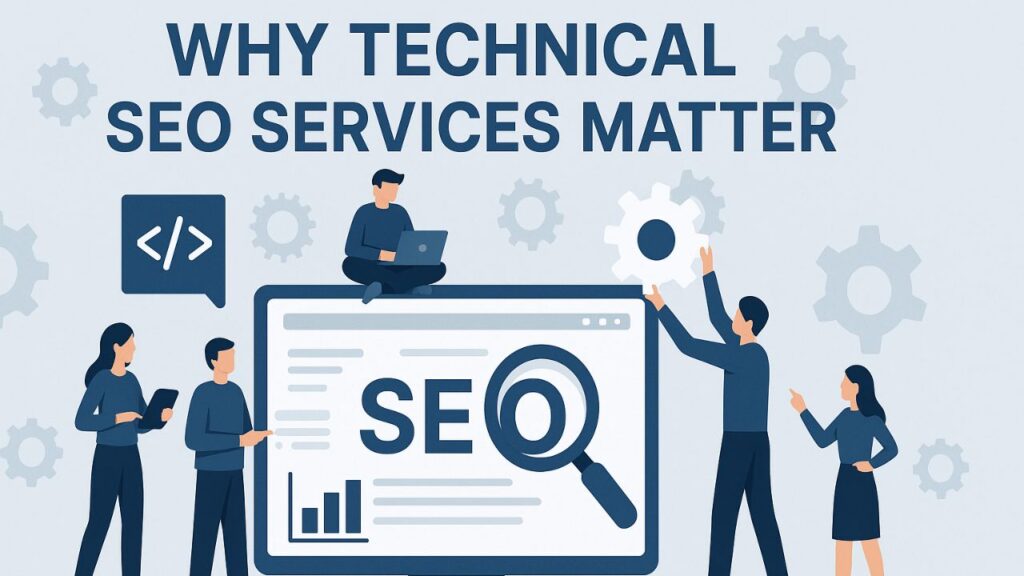In today’s interconnected web, every website acts as a node in a vast network of information. From local news sources and e-commerce platforms to educational portals and community forums, websites permeate every aspect of our online experience. Ensuring these sites are not only visible—but also fast, secure, and user-friendly—requires a strong underlying structure. That’s where technical SEO services become indispensable.
Technical SEO services focus on optimizing a website’s infrastructure so that search engines like Google, Bing, and others can efficiently crawl, index, and present content in search results. Unlike content creation or link-building strategies, which operate at the surface level, technical SEO addresses the “plumbing” of the web—improving everything from site speed and mobile compatibility to archive structure and secure connections.
This comprehensive guide explores the educational foundations of technical SEO services, covering:
- What technical SEO entails and why it stands apart from other SEO disciplines
- Critical components of a robust technical SEO strategy
- Key tools and frameworks that help execute and monitor improvements
- Benefits of a technically sound website
- Maintenance workflows to sustain optimal health
- Strategic recommendations grounded in engineering best practices
- FAQ section addressing common queries about implementing technical solutions
This journey will shed light on the structural backbone that supports search visibility, user satisfaction, and long-term website resilience. Let’s explore why investing attention in technical SEO is more than worthwhile—it’s essential.
Table of Contents
1. What Are Technical SEO Services?
Technical SEO services refer to a collection of engineering practices aimed at ensuring that websites meet baseline technical standards expected by search engines. Unlike content-focused optimization—such as keyword targeting or editorial writing—technical SEO targets the infrastructure, protocols, and metadata that enable effective crawling, rendering, indexing, and ranking.
At its core, technical SEO involves:
- Crawling and indexing controls via XML sitemaps, robots.txt, and canonical tags
- Page performance improvements through compression, caching, and resource minimization
- Mobile optimization including responsive design and mobile usability
- Secure HTTPS implementation with valid certificates and proper configuration
- Clean URL structures and metadata for easier parsing and better click-throughs
- Structured data markup to enhance SERP appearance (e.g., breadcrumbs, FAQs)
- Logical site architecture and internal linking to guide bots and human users
- Media optimization including lazy loading and adaptive formats
- Error handling, redirects, and log file analysis
Each of these areas plays a unique role in how search engines interpret and rank a site. Together, they constitute a holistic approach to improving both machine and human interaction with a digital property.
2. Core Components of Technical SEO Services
Below, we delve into the primary areas that technical SEO services address. Each subsection explains why the element matters and outlines best-practice solutions.
2.1 Crawling & Indexation
Search engines rely on bots to crawl web pages methodically. To guide them effectively, technical SEO services set up:
- XML sitemaps that list primary URLs with metadata like last-modified dates and priority
- Robots.txt files to clearly define crawlable vs. off-limits resources
- Canonical tags to resolve duplicate content and consolidate ranking signals
- URL parameter handling rules to prevent indexing of redundant query strings
By managing how bots access content, technical SEO ensures priority pages get indexed—and that search engines don’t waste time on irrelevant or duplicate resources.
2.2 Site Speed & Performance
Website performance directly impacts search rankings and user satisfaction. Technical SEO services improve loading times through:
- Compressing assets using GZIP or Brotli
- Minifying CSS, JavaScript, and HTML
- Configuring browser caching and server-side caching
- Leveraging Content Delivery Networks (CDNs) for asset distribution
- Optimizing server response times via efficient code and hosting
Faster sites boost engagement, reduce bounce rates, and send positive signals to search algorithms.
2.3 Mobile-First Optimization
The shift to a mobile-first index means search engines now use mobile versions of URLs for crawling and ranking. Technical optimizations include:
- Responsive design principles for adaptive layouts and media
- Viewport and Meta tags to ensure correct rendering on diverse devices
- Touch-target and font scaling improvements
- Mobile UX audits and addressing issues like interstitials or intrusive pop-ups
A mobile-optimized site meets user expectations and aligns with current indexing priorities.
2.4 Secure HTTPS Implementation
Security is now a factor in search visibility. Technical SEO services ensure:
- Valid SSL/TLS certificates covering all relevant domains
- HTTP to HTTPS redirects avoiding mixed content scenarios
- Regular renewals to prevent unintended downtimes
A secure connection builds user trust and aligns with search engine expectations.
2.5 URL Structure & Metadata
Clean URLs and descriptive metadata aid search engines in interpreting content. Best practices include:
- Short, semantic URL slugs reflecting page content
- Consistent use of lowercase letters and hyphens
- Title tags and meta descriptions that improve clarity and click-through rates
- Header tag hierarchies (H1, H2, H3) for structural clarity
Metadata doesn’t directly boost rankings but enhances visibility and engagement in SERPs.
2.6 Structured Data & Schema
Structured data provides additional context to search engines by marking up content in a machine-readable format. Using schemas from Schema.org, websites can communicate specific types of information such as products, reviews, FAQs, or events.
Implementing structured data enables:
- Rich snippets like star ratings, breadcrumbs, and how-to steps in search results
- Improved categorization of content, such as recognizing a recipe, organization, or article
- Enhanced click-through rates, since enriched SERP results are often more eye-catching
Markup should be validated using tools like the Rich Results Test to ensure compliance. Incorrect or spammy use can lead to manual actions by search engines.
2.7 Internal Linking & Site Architecture
Well-structured sites allow both users and search engines to navigate easily. Key practices include:
- Logical page hierarchies (homepage → category → subcategory → article/product)
- Consistent internal linking, allowing page authority to flow effectively
- Breadcrumb navigation for better context and user orientation
- Flat architecture, ensuring important pages are within 3–4 clicks of the homepage
Efficient architecture supports discoverability and reduces orphaned content.
2.8 Image & Media Optimization
Visual elements can significantly affect load speed and usability. Optimization includes:
- Choosing appropriate formats (e.g., WebP or AVIF over PNG for photos)
- Lazy-loading non-critical media
- Compressing file sizes without noticeable quality loss
- Adding alt text to images for accessibility and context
Videos and PDFs should also be embedded or linked in search-friendly ways, using schema markup and structured naming.
2.9 Core Web Vitals & UX Metrics
Core Web Vitals are performance-based metrics that Google uses to assess user experience. These include:
- Largest Contentful Paint (LCP): Measures loading performance
- First Input Delay (FID): Assesses interactivity
- Cumulative Layout Shift (CLS): Evaluates visual stability
Technical SEO services target these metrics using methods like asynchronous script loading, image optimization, and efficient code practices.
2.10 Error Handling, Redirects & Log Analysis
Maintaining site integrity involves:
- Managing 404 errors and soft 404s
- Implementing 301 and 302 redirects to preserve link equity
- Reviewing server logs to monitor crawl activity and identify unexpected bot behavior
- Addressing crawl anomalies through tools like Google Search Console
Proper error and redirect management prevents crawl budget waste and preserves user trust.
3. Tools & Frameworks for Technical SEO
Technical SEO relies heavily on tools to audit and diagnose performance issues. While services may differ in their preferred software stack, most workflows include combinations of:
- Google Search Console: For coverage reports, indexing status, and performance tracking
- Google PageSpeed Insights / Lighthouse: Core Web Vitals diagnostics
- Screaming Frog or Sitebulb: Crawling tools to identify issues at scale
- WebPageTest: In-depth performance and rendering analysis
- Log file analyzers: To assess how bots interact with the server
- Schema validators: Like Rich Results Test and Schema Markup Validator
- Chrome DevTools: For performance audits, network analysis, and code debugging
These tools work in concert to provide full visibility into a site’s technical profile, forming the basis for prioritizing and resolving issues.
4. Benefits of Investing in Technical SEO Services

The advantages of a well-executed technical SEO strategy extend far beyond crawl efficiency. These include:
- Improved crawlability and indexation, ensuring important pages are visible in search engines
- Faster loading speeds, contributing to better user satisfaction and lower bounce rates
- Higher rankings, particularly when competing websites lack technical foundations
- Mobile usability, crucial in an increasingly mobile-first world
- Rich search appearances, improving engagement through structured data
- Long-term scalability, as structured sites are easier to grow and maintain
- Security and compliance, particularly with HTTPS and accessibility guidelines
By addressing these areas, technical SEO services create the conditions under which content and link strategies can perform optimally.
5. Ongoing Maintenance & Monitoring
Technical SEO is not a one-time task. Algorithms evolve, technologies change, and site content expands. Maintaining technical integrity involves:
- Scheduled audits (monthly or quarterly) to detect new issues
- Crawl monitoring using server logs and Google Search Console
- Continuous performance tracking, particularly Core Web Vitals
- Testing during redesigns or migrations, ensuring no regressions occur
- URL monitoring for changes or canonical mismatches
Regular maintenance helps avoid regressions that might silently erode visibility or user experience over time. Technical SEO services often include alert systems to flag critical issues in real-time.
6. Summary and Strategic Recommendations
A sound technical foundation is essential for sustainable visibility in organic search. While content and backlinks are visible and often prioritized, technical SEO ensures those investments yield results. It improves discoverability, supports accessibility, boosts performance, and sets the stage for structured growth.
Strategic best practices include:
- Regularly auditing your site using structured frameworks
- Automating checks for speed, security, and crawl errors
- Using validated schema markup for enhanced SERP appearance
- Prioritizing mobile usability and loading performance
- Ensuring that all updates pass through QA processes
Investing in technical SEO services is not just about solving current problems—it’s about preparing your site to meet future expectations in search engine technology and user experience.
FAQ
1. What is the difference between technical SEO and on-page SEO?
Technical SEO focuses on backend infrastructure, while on-page SEO deals with content and front-end elements like keywords and formatting.
2. Are technical SEO services needed for small websites?
Yes. Even small sites benefit from improved crawlability, speed, and indexation.
3. How often should a technical SEO audit be conducted?
Best practice suggests quarterly audits, or more frequently for dynamic, high-traffic sites.
Final Words
Technical SEO services serve as the structural foundation for successful digital presence. Without them, even the most compelling content can struggle to gain traction. By understanding and implementing sound technical principles, websites can become more accessible, more secure, and better positioned to grow with the evolving web.



